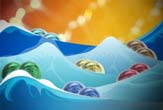The Strangest Little Things in Nature

When small cannot get any smaller, you enter the quantum world of quarks, photons, and space-time foam. You're welcome to take a look at this indivisible side of nature, but just remember to leave your common sense at the door.
People as far back as the Greek philosopher Democritus believed that things were built up from irreducible pieces. Isaac Newton himself thought that light was not a wave, but rather a collection of tiny "corpuscules." Physicists have only recently acquired tools with sufficient resolution to see nature's inherent graininess.
Here's a quick tour of the quantum underbelly of the things around us.
Matter
If you split a banana, and then split it again, and again, and again... you eventually get down to cells, molecules, atoms. Each atom has a nucleus of protons and neutrons, with tiny electrons buzzing around. Both protons and neutrons contain three quarks.
But the dissection stops there: electrons and quarks are the smallest pieces of ordinary matter.
How small are they? The electron is sometimes said be a few femtometers across (about a trillionth of a hair's width), but this is misleading. Electrons and quarks are more like puffy clouds than rigid balls.
Get the world’s most fascinating discoveries delivered straight to your inbox.
This puffiness is the result of unavoidable quantum uncertainty: You can't precisely know a particle's motion and position at the same time. If you try to hold a quark still, you would have almost no idea where it is.
Such slipperiness makes exact size measurements meaningless.
Light
If we turn our scalpel on light, we find that its seemingly continuous glow is actually composed of little bundles of energy, called photons. Don't bother squinting your eyes to see them, though: a 100 Watt bulb emits a billion trillion photons per second.
So was Newton right? Light is a particle, not a wave? The answer is yes and no.
Light acts like a wave when you do an experiment looking for a wave property (like scattering through a pinhole). It behaves like a particle if you test for a particle property (like colliding with electrons).
"You get what you ask for" is a common refrain in quantum physics.
Rotation
Particle properties can be "quantized" as well. Probably the weirdest example is particle rotation (what is called spin) which, by the way, is nothing like how a planet or a top moves.
First of all, particles have only one rotation speed—they can't speed up or slow down.
And second, the axis of rotation depends on how you look at it. In an experiment, one detector might report a particle's spin points North, while another detector might say East. And they'd both be right!
Gravity
The force of gravity has largely resisted this quantum tomfoolery. But some physicists believe that Newton's apple fell from its tree thanks to gravitons—photon-like particles that carry the gravitational attraction.
Falling apples would not generate a lot of gravitons, but colliding black holes would. Detectors are currently looking for signals from these distant collisions, but it may be many years before any evidence for gravitons is found.
Vacuum
Even nothing acts strange at the smallest levels. The vacuum is presumably not really empty, but instead filled with "virtual" particles that constantly blink in and out of existence.
This virtual reality follows from a quantum rule that says probable events influence real outcomes. More specifically, it is possible (though highly unlikely) for particles and anti-particles to pop out of nowhere and then quickly annihilate. Nobody ever sees this happen, but the sum of all this quantum probability is a real energy.
Space and time
The above vacuum energy is not constant: it seethes and fizzles with bubbles the size of the Planck length (see box). This foam warps the fabric of space-time, blurring the answers to when and where.
Essentially, the underlying geometry of the world is not smooth. Instead, there are "pixels" that cannot be further resolved. Particles do not move continuously, but instead make little quantum leaps from one pixel to the next.
Such quantized space-time, though not yet observed, is the endpoint of smallness, as well as the end of this tour.
 Live Science Plus
Live Science Plus






